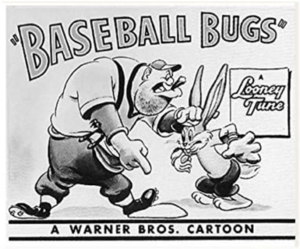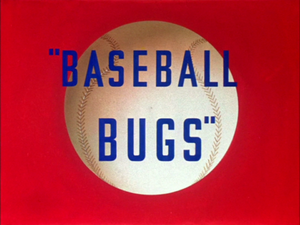Baseball Bugs
| Baseball Bugs | |
|---|---|
 Lobby card. | |
| Production company | Warner Bros. Cartoons |
| Distributor | Warner Bros. Pictures The Vitaphone Corporation |
| Release date | February 2, 1946 |
| Run time | 7:35 |
| Starring | Mel Blanc Tedd Pierce Frank Graham Bea Benaderet |
| Producer(s) | Eddie Selzer |
| Music composition | Carl W. Stalling |
| Story | Michael Maltese |
| Animation | Manuel Perez Ken Champin Virgil Ross Gerry Chiniquy |
| Director(s) | I. Freleng |
| Series navigation | |
| ← Previous | Next → |
| Title card | |

| |
Baseball Bugs is the two hundred and ninth Looney Tunes theatrical short. It was released by Warner Bros. Pictures and The Vitaphone Corporation on February 2, 1946. It was written by Michael Maltese, produced by Edward Selzer and directed by Friz Freleng.
Detailed summary
Memorable quotes
Bugs: Boo! Boo! Boo! Nah, the Gas-House Gorillas are a buncha dirty players. Why, I could beat them in a ball game with one hand tied behind my back all by myself. Yeah!
Announcer: Attention, please. Attention. There's been a slight change in the Tea Totaller lineup. Catching, Bugs Bunny. Left field, Bugs Bunny. Right field, Bugs Bunny. Pitching, Bugs Bunny. Third base, Bugs Bunny, center field, Bugs Bunny, first base, Bugs Bunny. Shortstop, Bugs Bunny. Second base, Bugs Bunny.
Bugs: That's the ol' pepper, boy! That's the ol' pitchin'! That's puttin' it over the plate, boy!
Bugs: Eeeh, I think I'll perplex 'em with my slowball!
Gas-House Gorilla: You're out!
Bugs: Where do ya get that malarkey, I'm safe!
Gas-House Gorilla: I said you're out!
Bugs: I'm safe!
Gas-House Gorilla: You're out!
Bugs: Safe!
Gas-House Gorilla: Out!
Bugs: Safe!
Gas-House Gorilla: Out!
Bugs: Safe!
Gas-House Gorilla: Out!
Bugs: Safe! Out!
Gas-House Gorilla: Safe!
Bugs: Out!
Gas-House Gorilla: Safe!
Bugs: Out!
Gas-House Gorilla: I say you're safe! If you don't like it, you can go to the showers.
Bugs: Okay then, Doc. Have it your way. I'm safe.
Bugs: Watch me paste this pathetic palooka with a powerful paralyzing perfect pachydermous percussion pitch.
Umpire: You're out!
Gas-House Gorilla: I'm out?!
Statue of Liberty: That's what the man said, you heard what he said, he said that, you...
Bugs: That's what the man said, he said that, that's what he said, he really said that, that's what he said...
Characters
In order of appearance: | ||||||||||||||||||||
| ||||||||||||||||||||
Organizations
Locations
- Earth
- United States
- New York
- New York City
- Baseball field
- Liberty Island
- New York City
- New York
- United States
Objects
Production
Development
Music
The music was composed by Carl W. Stalling.
Crew credits
- Layout: Hawley Pratt
- Background: Paul Julian
Release
Dates are in order of release:
- United States: February 2, 1946 in theatres
Behind the scenes
- The MPAA certificate number for this short is 10251.
- According to animation historian Michael Barrier, the cartoon marks a considerable shift for Bugs Bunny's opponents before and after World War II. Before the war, his foes were often portrayed as fools that Bugs held in disdain. However, after the war, the antagonists in cartoons directed by Freleng and others were made to be more formidable and menacing, which added an extra depth to Bugs' maneuvers and victories. In Baseball Bugs specifically, the Gas-House Gorillas were described by Barrier as "A whole team of interchangeable [...] hulking, blue-jawed, cigar chewing monsters".[1]
- During one of Bugs' pitches, he throws a fastball from the pitcher's mound, accelerates past it, and moves in position at home plate to catch it. Since it is a demonstration of cartoon physics, such acceleration would be impossible to perform in real life.[2]
- This is one of two Looney Tunes shorts–the other being Hare Tonic–to have a variant of the then-usual closing. Instead of Porky Pig coming out of a drum, Bugs performs the same act and proclaims "And that's the end!" while eating a carrot.
Errors
- By calculating the score of all the Gas-House Gorillas' runs by the time Bugs takes over the game, the team has 96 runs. By the end of the short, the Gorillas have 95 runs to Bugs' 96.
- The Statue of Liberty is shown with a copper coloring in the short, even though it already had oxidized to a green coating by 1906,[3] forty years before the short.
Legacy
- This short would be used in the 1951 Looney Tunes entry, His Hare Raising Tale.
- The 1954 short Gone Batty follows a similar premise to this cartoon, and recycles the certain gags from it.
Home availability
- In the United States:
References
- ↑ Barrier, Michael (1999), "What's Up, Warner Bros., 1945–1953" (p. 471), Hollywood Cartoons : American Animation in Its Golden Age. Oxford University Press, ISBN 978-0198020790.
- ↑ Van Riper, A. Bowdoin (2002). "Acceleration", Science in Popular Culture: A Reference Guide. Greenwood Press, page 4. ISBN 978-0313318221.
- ↑ "Answers About the Statue of Liberty". The New York Times. July 1, 2009.